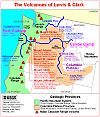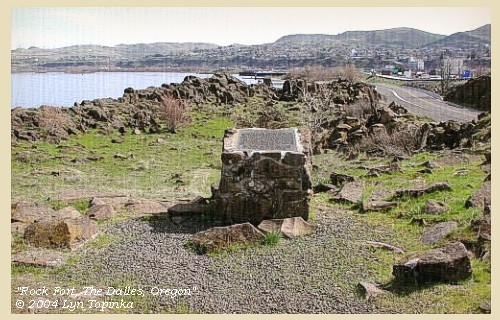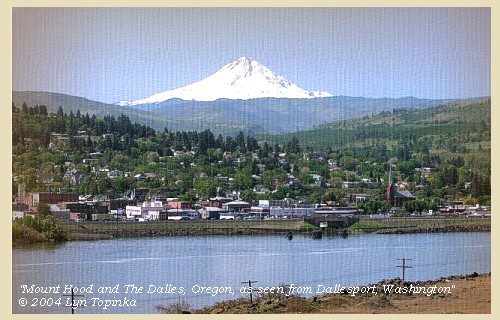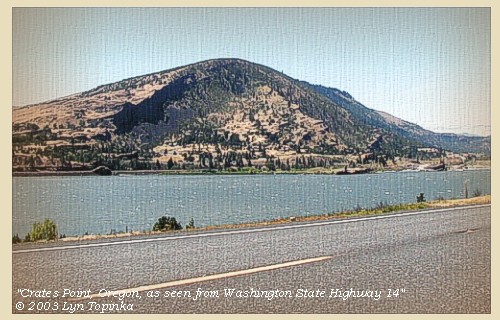The Volcanoes of
Lewis and Clark
Lewis and Clark
|
October 26 - 28, 1805 The Dalles - "Long Narrows" |
|
Home
The Volcanoes of Lewis and Clark Map of the Journey Volcanoes, Basalt Plateaus, Major Rivers, etc. The Volcanoes Mount Adams, Mount Hood, Mount Jefferson, Mount Rainier, and Mount St. Helens CALENDAR of the Journey October 1805 to June 1806 Along the Journey Pacific Northwest Maps - Columbia River, Volcanoes, Flood Basalts, Missoula Floods, Geology, etc. The Corps of Discovery The Journey of Lewis and Clark About the Reference Materials The Journals, Biddle/Allen, DeVoto, Gass, Moulton, Topo Maps, and others USGS Lewis and Clark Links Links to USGS Websites highlighting the Lewis and Clark Journey Resources Publications Referenced and Websites Visited |
PREVIOUS
October 25 The Dalles, "Long Narrows" |
October 26-28
The Dalles, "Long Narrows" Rock Fort, Mount Hood, Rocky Island and Crates Point |
CONTINUE
October 29 Entering the Columbia River Gorge, The Dalles to the Little White Salmon |
|
To the Pacific - October 1805
The Dalles - "Long Narrows" |
| Lewis and Clark's camp of October 25, 1805, was the first of three nights on their journey downstream spent at "Rock Fort", just downstream from Mill Creek, The Dalles, Oregon. |
| Saturday, October 26, 1805 |
| The morning was fine: we sent six men to hunt and to collect rosin to pitch the canoes, which, by being frequently hauled over rocks, have become very leaky. ...... We were occupied with the observations necessary to determine our longitude ...... |
| "... the Country to the Lard is broken Country thinly timbered with pine and white oake, a mountain which I must call 'Timm' or 'falls' Mountain rises verry high and bears to the S W the Course it has bore Sinc we first Saw it ..." [Clark, October 26, 1805] |
| The fleas, with whom we had contracted an intimacy at the falls, are so unwilling to leave us, that the men are obliged to throw off all their clothes, in order to relieve themselves from their persecution. |
|
|
|
The Camp - October 25 through October 27, 1805:
Lewis and Clark set up camp at "Rock Fort" during both their journey to the Pacific (October 25 through October 27, 1805) and their journey home (April 15 through April 17, 1806). |
| Sunday, October 27, 1805 |
| The wind was high from the westward during the night and this morning, but the weather begin fair we continued our celestial observations. ...... |
| "... The Creek at which we are Encamped is Called by the natives - 'Que-nett' - ... The pinical of Falls mountain bears S 43o W. about 35 miles [Mount Hood] ..." [Clark, October 27, 1805] |
|
|
|
The Camp - October 25 through October 27, 1805:
Lewis and Clark set up camp at "Rock Fort" during both their journey to the Pacific (October 25 through October 27, 1805) and their journey home (April 15 through April 17, 1806). |
| Monday, October 28, 1805 |
| The morning was again cool and windy. Having dried our goods, we were about setting out, when three canoes came from above to visit us, and at the same time two others from below arrived for the same purpose. ...... This interview detained us till nine o'clock, when we proceeded down the river, which is now bordered with cliffs of loose dark coloured rocks about ninety feet high with a thin covering of pine and other small trees. At the distance of four miles we reached a small village of eight houses under some high rocks on the right, with a small creek [Chenoweth Creek ???] on the opposite side of the river. We landed and found the houses similar to those we had seen at the great narrows ...... The wind however rose so high, that we were obliged after going one mile to land on the left side opposite to a rocky island [vicinity of today's Rocky Island], and pass the day there. We formed our camp in a niche above a point of high rocks [upstream of Crates Point], and as it was the only safe harbour we could find, submitted to the inconvenience of lying on the sand, exposed to the wind and rain during all the evening. ...... |
| "... the wind rose and we were obliged to lie by about 1 mile below on the Lard. Side North 1 mile to a rock Island on the Stard. Side. ... rained all the evenig & blew hard from the West encamped on the Lard Side opsd. an Rock in a verry Bad place ..." [Clark, October 28, 1805] |
|
|
|
The Camp - October 28, 1805:
Oregon side of the Columbia River, near Rocky Island, Oregon, upstream of Crate's Point. |
| Home | Previous | Continue |
If you have questions or comments please contact: GS-CVO-WEB@usgs.gov
June/July 2004, Lyn Topinka
The Volcanoes of Lewis and Clark Home Page | CVO Home Page





















